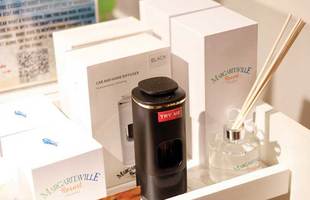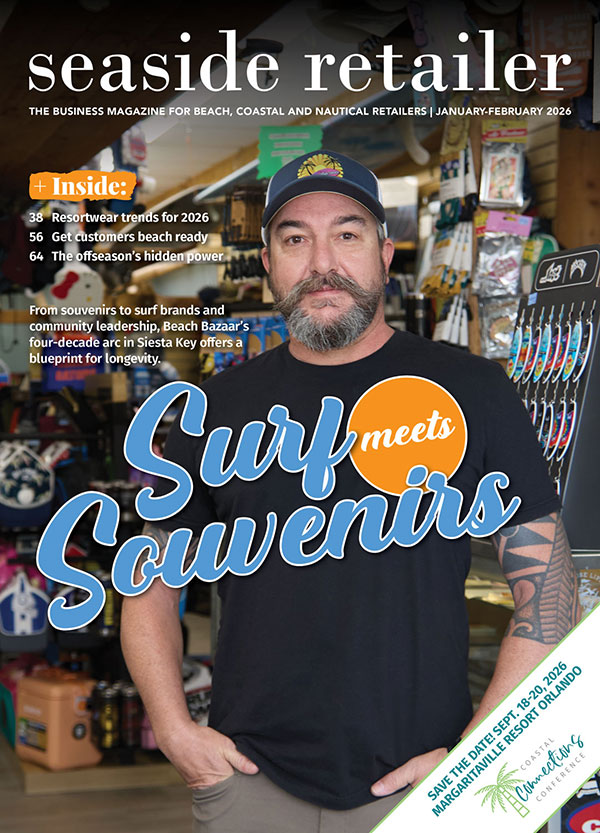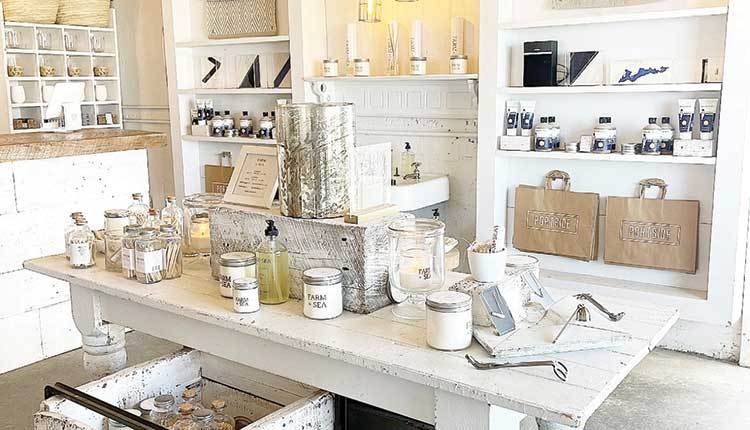
Merchandising a seaside store is probably one of the biggest tasks a store owner, manager or buyer has. Stores based in coastal locations carry a wide variety of goods that can range from home decor like candles and wooden signs to beach accessories like beach towels, sunglasses and sunblock. There’s also souvenirs like drinkware and T-shirts to factor in.
And while choosing all the right items to carry is important, deciding the right fixtures to display them on could be the deciding factor between an item that flies off the shelf or one that collects dust. These tables, shelves, racks and other receptacles upon which your store’s offerings will rest might seem like a secondary consideration, but the decision of what to incorporate impacts your store’s overall vibe and bottom line.
“Fixtures help define the personality of a business,” says consultant Nicole Leinbach, founder of Denver-based independent retailer consulting firm, Retail Minded. “You want to make sure that they complement your overall branding, including the personality you want your consumers to feel. It should be part of your initial thought process as you are designing the store.”
Conventional store fixtures such as rounders, racks and spinners, while functional, don’t have much personality. Happily, there is a world of other furnishings out there that are loaded with it.
Great crates
Wood conveys warmth, texture and a homey, welcoming feel. If you visit 98 Treasures, Gulf Breeze, Florida, a store with multiple vendors, you’ll see a lot of wood in the form of small wooden crates, the kind you can get at a craft store. “They’re amazing,” says owner Heather Bennett. “So cute, and they look really good with the coastal decor, suggesting crab traps and things like that. They give the store a really nice beachy vibe.”
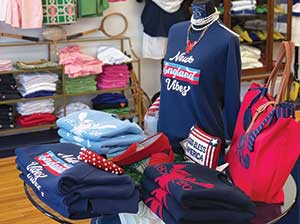
And they’re versatile. “You can stack them, you can use them as lifts and risers. I have some screwed into my walls to make displays. I use them on top of shelves, too, so that I get two shelves in one,” she adds.
Medea Harris is lucky enough to have access to the real deal — antique lobster crates. They fit perfectly in her New England-preppy/yacht-club-themed store Maine and Ivy (also the name of her clothing line), Boothbay Harbor, Maine. “The antique lobster crates are authentic ones from this area,” she says. “I’ll tip them on their sides to feature pillows that we carry or hang dresses from them.”
Their portability appeals to her as well. “Freestanding displays are easy to maneuver,” she says — which also fits the way she views her business, as a favorite outfit that she wears a lot but changes the accessories.
Wood is also the watchword at Portside, a gift store in Noank, Connecticut. “Nothing I have is a standard fixture like a spinning rack,” says owner Wendy Hille. “Instead, I have a variety of repurposed and reclaimed wood items that I use in the shop. The closest thing I have to something traditional are some Kallax cubes from Ikea, but everything else is made from vintage barn wood or old batten doors, things like that.”
Salvaged and found items
Portside is located in an old boat repair shop “right on the dock of a shipyard with a big glass garage door that opens up to the dock.” Hille strives to preserve the old-timey seafaring vibe that’s built into the store, and her dockside location helps her do just that — by letting her reap a bounty of discarded items you can smell the salt air on.
“When they hoist boats out of the water, they put these big wooden blocks underneath to keep them standing upright so they can work on them,” Hille explains. “When they’re done, they leave them laying all over the shipyard. So I’ll take them and use them to elevate my products on the tables just to give them some height and dimension. The boat blocks are an absolute must for me.”
She finds other discards, too, that are ripe for rescue. “When electricians work at the shipyard, they’ll take wire off these big wooden spools. When they’re empty, I’ll paint them and use them as tables.”
Hille has some custom-built fixtures, but she hasn’t had to rely on them strictly. As she discovered, put the word out that you’re looking for salvage, and you might be surprised at what comes your way. “A friend of mine brought me a mantel from a fireplace that his builder was getting rid of,” she recalls. “I installed it under one of the windows and it became a great-looking display.”
As did an old vintage sink. “My plumber pulled it out of an old house — it’s perfect in here,” Hille says. “I use it to display little travel-sized lotions from the Farm + Sea line that I carry. Above that I have an old antique white shelf that I got at the same place I get my vintage wood. I like the mix of the wood and the nice, crisp enamel sink next to it.”
Bennett, too, is part of the Sisterhood of the Salvaged Sink. “I have this really old dry sink that I use for my kitchen tools. It’s a good way to display them without having random stuff everywhere. I’ll never sell it because it’s a conversation piece. It’s interesting to look at, and it also gives the customers something to talk about.”
Found and salvaged fixtures make sense for cash-strapped proprietors trying to survive the pandemic. “Many merchants are on a dime these days,” says Leinbach. “Maybe new fixtures aren’t in their budget.” These items come loaded with atmosphere and are frequently free. What could be more budget-friendly than that?
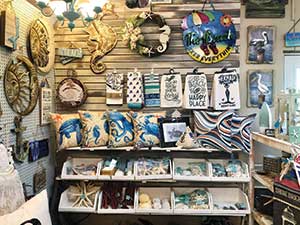 98 Treasures’ slatwall is lined with whitewashed containers and hooks.
98 Treasures’ slatwall is lined with whitewashed containers and hooks.

Repurposing antiques (and other stuff)
In setting up Maine and Ivy, Harris took the antique cherry wood dining table she inherited from her grandmother and did something to it that she says made some of her girlfriends shudder.
“I cut it in half and mounted one of the halves to the wall to use as a display.” Although her friends kept asking, “Are you sure you want to do this?” she was resolute.
“I said, ‘Absolutely,’ — and I just love the way it looks.” She even thinks her grandmother would have approved.
Other reclaimed fixtures at Maine and Ivy include an old rope ladder and a set of moose antlers. “You see those antlers in a lot of homes here in Maine,” says Harris. “We use them to display hats. And the rope ladder is the kind they would throw over the side of a ship. We display more hats and also shoes on its rungs.”
New stuff can be made to look old, as Harris discovered when she needed wall racks. “We just literally went to our local hardware store, got pipes, spray-painted them antique gold and mounted them to the wall,” she recalls. “We also used them to make standing clothing racks. They’re fabulous for long dresses and also purses and bags because you can adjust the height however you need,” says Harris.
While Harris concedes that the plumbing supplies have “an industrial kind of look,” they also convey a nautical feel. “They look just like the sort of heavy pieces you would find on a sailboat or ship.”
Of all of Portside’s reclaimed furnishings, two long wooden farm tables are among Hille’s absolute must-haves. “They’re the center of all my displays,” she says.
Hille uses other repurposed items, large and small, wherever possible. Instead of plastic mannequins, for example, she uses antique dress forms, the ones with the metal cages on the bottom. Her shopping bags hang from an old metal boat cleat. “I look for reclaimed items on Facebook Marketplace,” she says. “I found this great three-piece metal rack with beat-up wooden drawers. I painted those white and keep my extra candles in there.”
Fixtures that sell
A beautiful or unusual fixture can become a conversation piece and promote add-on sales. “Putting your products on a fixture that people are drawn to makes them want to buy what’s on top of it,” says Hille. “It’s a mechanism that gets people to want to purchase things,” she says. “I’ll set up tables to show how the different items would look in people’s homes, so they can visualize that.”
“The antique lobster crates are authentic ones from this area. I’ll tip them on their sides to feature pillows that we carry or hang dresses from them.” – Medea Harris, Maine and Ivy
Leinbach recalls “a really beautiful, big vintage chair in a clothing and accessories store reupholstered in hot pink, which fit the store’s personality and branding.”
The store had draped long scarves over the chairs’ back. “It was positioned right outside the dressing rooms, and the sales associates were trained to take a scarf and say, ‘This would be a fun accessory for that outfit.’”
The chair helped sell the scarves. “That’s the big takeaway,” says Leinbach —”that the best displays and fixtures function as additional sales associates” — ones that you don’t have to pay or manage!
Making it all work together
One might think that having so many disparate elements would make a store look as if a swap meet just exploded. But Hille manages to pull everything together in a look she describes as distressed farmhouse.
Sticking to one color is key. “My store is very monochromatic,” she says. “Everything is uniform; I paint everything decorator white, then distress it. Then I accent the tabletops with neutral colors — grays, navies and tans. It gives the store a cohesive look, so you don’t have a million colors going on, and it makes the merchandise stand out better.”
Perhaps the best example of the distressed farmhouse look is a reclaimed door that was made into a table — its legs, the columns from an old porch. “It was put together so it looks really rustic,” Hille says. “I painted it so that it has a nice, shabby-chic, chipping-paint look. And I also have a beautiful old Dutch cabinet where I store a lot of linens, things like that.”
Even if you’re stuck with a bunch of traditional fixtures, Leinbach suggests “zhooshing” them up. “If you exclusively have traditional fixtures, and you’ve not been able to or can’t afford to change them (or they’re built in) you can still incorporate creative ideas.”
Like creating a display atop or around a conventional rack or rounder, says Leinbach. “You can put something on the top shelf of a rounder that’s complementary to your store’s aesthetic — use it as a place to incorporate nautical or coastal-themed displays,” for example, an old diving helmet surrounded by sea-scented candles.
Using unusual fixtures is a wonderful way to express your seaside store’s unique personality — and your own. Why not give it a whirl?


